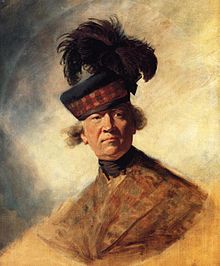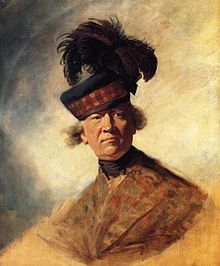Archibald Montgomerie was born on 18 May 1726, to Alexander Montgomerie, 9th Earl of Eglinton and the 9th Earl's third wife, Susanna Kennedy. Montgomerie was one of the 9th Earls 20 children. Montgomerie was educated at Eton during his teenage years. He then went to Winchester College. At age 13, Montgomerie joined the army.
After joining the army, Montgomerie received a commission as a Cornet. He served as a Cornet, from 1739 until 1740. He received this commission in the Scots Greys. At the outbreak of the Seven Years' War, Montgomerie raised the Montgomerie's Highlanders. He was elected Lieutenant-Colonel of the regiment, on 4 January 1757. The regiment traveled to the American Colonies, in 1757. Montgomerie was put under the command of General Amherst. Montgomerie and his regiment fought with George Washington, and Henry Bouquet at the expedition against Fort Duquesne, in 1758. In 1760, he commanded an expedition against the Cherokee during the Anglo-Cherokee War. Montgomerie's expedition, which included 1,200 men, was successful in its mission. Montgomerie had several Cherokee villages destroyed, including Estatoe. He defeated the Cherokees, in 1760, at the Battle of Etchocy, and again defeated the Cherokees, in 1761, at the Battle of War-Woman's Creek.
Archibald Montgomerie, by Sir Joshua Reynolds
Between 1767 and 1795, Montgomerie was the colonel of the 51st Regiment of Foot. During his service with the 51st, Montgomerie fought in the French Revolutionary Wars. Montgomerie rose through the ranks of the British Military, and became a Major General, in 1772. He was Deputy Vice-Admiral of Irvine in 1777, within the Port of Irvine from Kelly Bridge to the Troon Point. He subsequently became a Lieutenant General, in 1777. In 1793, Montgomerie was commissioned a Full General. From 1795 until 1796, Montgomerie was the Colonel of the Royal Scots Greys (2nd Dragoons).
Montgomerie ran for a position in the House of Commons, in 1761. After the election was over, Montgomerie found that he was elected to two seats. He chose to give up Wigtown Burghs, to sit in the seat for Ayrshire. He served in the House of Commons, from 1761 until 1768. Montgomerie served as a Whig. In 1761, Montgomerie became an Equerry for Queen Charlotte. He was appointed Governor of Dumbarton Castle, in 1764. Montgomerie was then appointed Deputy Ranger of St. James's Park and Deputy Ranger of Hyde Park, in 1766.
Montgomerie's first wife Lady Jean (Jane) Lindsay.
On 24 October 1769, Montgomerie's brother, Alexander Montgomerie, 10th Earl of Eglinton, was shot by Mungo Campbell. Campbell shot the 10th Earl, after a dispute on whether or not Campbell could bear arms on the 10th Earl's property. The 10th Earl died, in the early morning hours, on 25 October 1769 and Montgomerie inherited the Earldom.
He was Grand Master of the Masonic Lodge of Mother Kilwinning, from 1771 until 1796. Montgomerie was elected as one of sixteen Scottish representative peers, in 1776. He was re-elected, in 1780, 1784, and 1790. Montgomerie was appointed Governor of Edinburgh Castle, in 1782. He served as Lord Lieutenant of Ayrshire, between 1794 and 1796. Montgomerie was also the patron for, the poet, Robert Burns.[16] Burns and Montgomerie would keep in contact until 30 October 1796 when Montgomerie died at Eglinton Castle.
After his death, the Earldom passed to a third cousin, Hugh Montgomerie, 12th Earl of Eglinton. Although the Earldom passed to Hugh Montgomerie, the majority of Archibald Montgomerie's wealth went to his daughter Mary. Mary's son, Archibald Montgomerie, 13th Earl of Eglinton, would eventually become the Earl of Eglinton.
There is a portrait of Montgomerie in Windsor Castle. It was offered back to the family, by King William IV, but the 13th Earl of Eglinton declined. He felt that it was an honor to have a portrait of his grandfather, at Windsor Castle.
Montgomerie was married, twice during his lifetime. He was first married, to Lady Jean (Jane) Lindsay. She was the daughter of George Lindsay-Crawford, 21st Earl of Crawford and Lady Jean Hamilton. They married, on 30 March 1772. Jean died, in 1778, without issue. Montgomerie married secondly, to Frances Twysden. She was the daughter of Sir William Twysden, 6th Baronet and Mary Jervis. They married, on 9 August 1783 and divorced on 6 February 1788 on account on her affair with Douglas Hamilton, the 8th Duke of Hamilton with whom she allegedly had a daughte
Archibald Montgomerie was born on 18 May 1726, to Alexander Montgomerie, 9th Earl of Eglinton and the 9th Earl's third wife, Susanna Kennedy. Montgomerie was one of the 9th Earls 20 children. Montgomerie was educated at Eton during his teenage years. He then went to Winchester College. At age 13, Montgomerie joined the army.
After joining the army, Montgomerie received a commission as a Cornet. He served as a Cornet, from 1739 until 1740. He received this commission in the Scots Greys. At the outbreak of the Seven Years' War, Montgomerie raised the Montgomerie's Highlanders. He was elected Lieutenant-Colonel of the regiment, on 4 January 1757. The regiment traveled to the American Colonies, in 1757. Montgomerie was put under the command of General Amherst. Montgomerie and his regiment fought with George Washington, and Henry Bouquet at the expedition against Fort Duquesne, in 1758. In 1760, he commanded an expedition against the Cherokee during the Anglo-Cherokee War. Montgomerie's expedition, which included 1,200 men, was successful in its mission. Montgomerie had several Cherokee villages destroyed, including Estatoe. He defeated the Cherokees, in 1760, at the Battle of Etchocy, and again defeated the Cherokees, in 1761, at the Battle of War-Woman's Creek.
Archibald Montgomerie, by Sir Joshua Reynolds
Between 1767 and 1795, Montgomerie was the colonel of the 51st Regiment of Foot. During his service with the 51st, Montgomerie fought in the French Revolutionary Wars. Montgomerie rose through the ranks of the British Military, and became a Major General, in 1772. He was Deputy Vice-Admiral of Irvine in 1777, within the Port of Irvine from Kelly Bridge to the Troon Point. He subsequently became a Lieutenant General, in 1777. In 1793, Montgomerie was commissioned a Full General. From 1795 until 1796, Montgomerie was the Colonel of the Royal Scots Greys (2nd Dragoons).
Montgomerie ran for a position in the House of Commons, in 1761. After the election was over, Montgomerie found that he was elected to two seats. He chose to give up Wigtown Burghs, to sit in the seat for Ayrshire. He served in the House of Commons, from 1761 until 1768. Montgomerie served as a Whig. In 1761, Montgomerie became an Equerry for Queen Charlotte. He was appointed Governor of Dumbarton Castle, in 1764. Montgomerie was then appointed Deputy Ranger of St. James's Park and Deputy Ranger of Hyde Park, in 1766.
Montgomerie's first wife Lady Jean (Jane) Lindsay.
On 24 October 1769, Montgomerie's brother, Alexander Montgomerie, 10th Earl of Eglinton, was shot by Mungo Campbell. Campbell shot the 10th Earl, after a dispute on whether or not Campbell could bear arms on the 10th Earl's property. The 10th Earl died, in the early morning hours, on 25 October 1769 and Montgomerie inherited the Earldom.
He was Grand Master of the Masonic Lodge of Mother Kilwinning, from 1771 until 1796. Montgomerie was elected as one of sixteen Scottish representative peers, in 1776. He was re-elected, in 1780, 1784, and 1790. Montgomerie was appointed Governor of Edinburgh Castle, in 1782. He served as Lord Lieutenant of Ayrshire, between 1794 and 1796. Montgomerie was also the patron for, the poet, Robert Burns.[16] Burns and Montgomerie would keep in contact until 30 October 1796 when Montgomerie died at Eglinton Castle.
After his death, the Earldom passed to a third cousin, Hugh Montgomerie, 12th Earl of Eglinton. Although the Earldom passed to Hugh Montgomerie, the majority of Archibald Montgomerie's wealth went to his daughter Mary. Mary's son, Archibald Montgomerie, 13th Earl of Eglinton, would eventually become the Earl of Eglinton.
There is a portrait of Montgomerie in Windsor Castle. It was offered back to the family, by King William IV, but the 13th Earl of Eglinton declined. He felt that it was an honor to have a portrait of his grandfather, at Windsor Castle.
Montgomerie was married, twice during his lifetime. He was first married, to Lady Jean (Jane) Lindsay. She was the daughter of George Lindsay-Crawford, 21st Earl of Crawford and Lady Jean Hamilton. They married, on 30 March 1772. Jean died, in 1778, without issue. Montgomerie married secondly, to Frances Twysden. She was the daughter of Sir William Twysden, 6th Baronet and Mary Jervis. They married, on 9 August 1783 and divorced on 6 February 1788 on account on her affair with Douglas Hamilton, the 8th Duke of Hamilton with whom she allegedly had a daughte
Gravesite Details
Bio courtesy Wikipedia
Advertisement
Records on Ancestry
Sponsored by Ancestry
Advertisement


